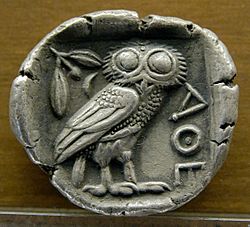Owl of Athena
[7][8] On the other hand, Cynthia Berger theorizes about the appeal of some characteristics of owls—such as their ability to see in the dark—to be used as symbol of wisdom[3] while others, such as William Geoffrey Arnott, propose a simple association between founding myths of Athens and the significant number of little owls in the region (a fact noted since antiquity by Aristophanes in The Birds and Lysistrata).
[9] In any case, the city of Athens seems to have adopted the owl as proof of allegiance to its patron virgin goddess,[9][10] who, according to a popular origin myth reproduced on the West pediment of the Parthenon, secured the favor of its citizens by providing them with a more enticing gift than Poseidon.
For example, in Ovid’s Metamorphoses, Corone the crow complains that her spot as the goddess' sacred bird is occupied by the owl, which in that particular story turns out to be Nyctimene, a cursed daughter of Epopeus, king of Lesbos.
[17] As for ancient Roman folklore, owls were considered harbingers of death if they hooted while perched on a roof, and placing one of its feathers near someone sleeping could prompt him or her to speak and reveal their secrets.
In affirmative contrast, the 19th-century German idealist philosopher Georg Wilhelm Friedrich Hegel famously noted that "the owl of Minerva spreads its wings only with the falling of the dusk"; philosophy comes to understand a historical condition just as it passes away.


